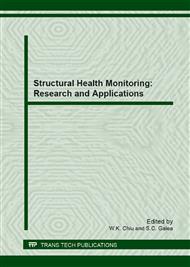p.341
p.349
p.357
p.364
p.374
p.386
p.400
p.411
p.424
An Enhanced Experimental Facility for Durability and Performance Characterisation of Piezoelectric Transducers for Structural Health Monitoring
Abstract:
With any structural health monitoring (SHM) system, verification of the health of the sensing elements is essential in ensuring confidence in the measurements furnished by the system. In particular, SHM systems utilised for structural hot spot monitoring applications will conceivably require transducers to operate reliably after sustained exposure to severe mechanical loading. Consequently, a good understanding of the long term mechanical durability performance of structurally integrated piezoelectric transducers is vital when designing and implementing robust SHM systems. An experimental facility has been developed at the Australian Defence Science and Technology Organisation (DSTO) capable of performing an autonomous long-term mechanical durability test on piezoceramic transducers. The Autonomous Mechanical Durability Experimentation and Analysis System (AMeDEAS) incorporates a general purpose data acquisition program controlling up to three 8-channel relay multiplexers and two instruments. AMeDEAS is highly flexible, allowing user-specified channel configurations and automatic interrogation of selected instruments. The system also interfaces with the uni-axial mechanical testing machine to provide control of the load sequence allowing transducer elements to be interrogated under stable load-free conditions after being subject to a predefined loading regime. AMeDEAS was used to investigate the fatigue characteristics of a low-profile layered piezoceramic transducer package developed by DSTO. A total of 16 transducers were tested under tension-dominated cyclic loading with peak-to-peak strain amplitude increasing from 400 με to a maximum of 3000 με, with periodic acoustic transduction efficiency and electromechanical impedance measurements taken throughout the test. This paper details the AMeDEAS and includes preliminary results which confirm the efficacy of the new facility.
Info:
Periodical:
Pages:
374-385
Citation:
Online since:
June 2013
Authors:
Price:
Сopyright:
© 2013 Trans Tech Publications Ltd. All Rights Reserved
Share:
Citation:


